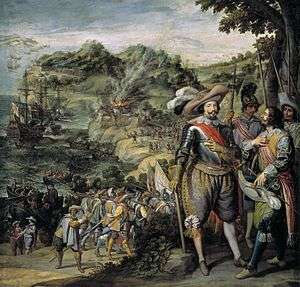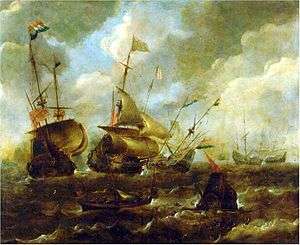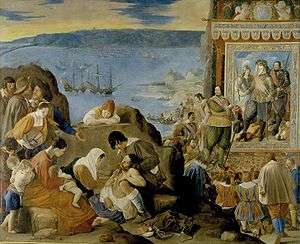Battle of Gibraltar (1621)
| ||||||||||||||||||||||||||||||
The Battle of Gibraltar (Spanish: Combate naval de Gibraltar, Dutch: Zeeslag bij Gibraltar 1621) took place on 10 August 1621 during the Eighty Years' War. A Dutch VOC fleet, escorted by Haultain's squadron was intercepted and defeated by nine ships of Spain's Atlantic fleet Armada del Mar Océano, under Fadrique de Toledo, while crossing the Strait of Gibraltar.[6][8]
Upon expiration of the Twelve Years' Truce between Spain and the United Provinces, the Spanish wanted to give a decisive blow intercepting the Dutch trading ships that were in the Mediterranean. To this, the Spanish had arranged for a fleet concentration squadron in the Bay of Gibraltar, but admirals Martín de Vallecilla, Juan Fajardo and don Francisco de Acevedo, with their respective squadrons, failed to join Fadrique's fleet which left Cádiz on August 6, 1621;thus having the later only 9 ships to face the Dutch enemy. Four days later the Dutch fleet was sighted with more than 50 ships, of which 20 were armed Warships and the rest were merchant.[6] Stubborn after don Fadrique addressed to a Dutch ship and surrendered, then took another and made a third strand. Commander Hoyos and Basque admirals Carlos de Ibarra and Don Alonso de Mujica managed to capture two ships and torch another one.[9] The Spanish flagship Santa Teresa ended dismasted and had to be taken in tow, but greater damage was done to the Dutch as more than five vessels were lost in the Barbary Coast and in Gibraltar.[6] The journey ended in Dutch defeat, passing the strait decreased in six or seven of his best ships, but having saved most of the merchant convoy.[6]
In the Spanish court, much was made of the event, posting it for a win, and the king made grants, pensions rewarded with the most they had distinguished themselves in combat, and Fadrique was given the rank of General captain of the People's War Kingdom of Portugal.[10]
Background
A temporary truce between Spain and her rebellious Netherlanders allowed Basque-Spaniard admiral Miguel de Vidazabal, commander of the Gibraltar squadron, to cooperate with Dutch ships in anti-Corsair operations. These resulted in sixteen Corsair vessels being brought into Gibraltar. The truce prompted by the clamor of public opinion and even more so by his minister the Count-Duke of Olivares, collapsed in 1621, and a Dutch and Danish fleet of thirty-one sail arrived in the Straits to do what damage it could to Spanish shipping.[11]
With fine strategic vision, the Count Duke of Olivares realized that, at this point, the only way to combat the young and prosperous commercial republic in which the Netherlands had become a powerful nation was by an offensive on the seas, which will deprive the vital supply convoys of the VOC. Philip IV of Spain ordered his squadrons to attack those convoys in the Bay of Gibraltar and Flanders.[12]
Spanish maritime intelligence knew that a convoy of at least twenty Dutch ships from Venice, broker of the Middle East, was always hostile to the Spanish and that the rich convoy had the necessity to pass through the Gibraltar Strait. All the Dutch ships would go well armed and equipped, and with an appreciable escort, thus capture it or destroy it seemed so desirable and appropriate for the Spanish admiralty.[6]
To achieve this, the Spanish Armada del Mar Océano, then the elite of the Spanish naval forces, had only nine ships commanded by Don Fadrique de Toledo y Osorio, this squadron had to met in Lisbon with four vessels under the command of Don Martin de Vallecilla, and nine of the fleet of Biscay, commanded by Don Francisco de Acevedo, bringing together about 22 ships that would ensure a complete victory.[6]
.jpg)
But the Spanish plans seemed to unravel quickly, because in spite of the sharp and urgent orders and the feverish activity undertaken or all found Acevedo Santander needed for artillery guns and had their vessels sail to Lisbon for such purposes with only ten pieces the captain, six at the admiral and four others which made it impossible for the time involved in a serious battle. And similar problems did Vallecilla in Lisbon to prepare his division.[6]
Prelude
For its part, the Armada del Océano commanded by Don Fadrique, better prepared, sailed from Cadiz on 31 July toward Cape St. Vincent, where he waited for the other two divisions, but realizing soon that they will not arrive in time for the planned attack. Despite its strategic importance, the Armada del Océano far from having the power it had in other times, it was reduced to the flagship Santa Teresa, a mighty galleon among the bests in Europe at that time, three other much smaller, about 450 tons, three more around 330 tons and two tenders of small military value except as scouts and messengers.[13] Such a force could not be enough against the enemy planned, and was, of course, much lower than initially planned. But Fadrique, one of the greatest admirals at the time, were not of those admirals that were seeking easy ways to evade the combat, complain about everything or blaming others for the planned fiasco. On August 6, he received a notice from Don Gaspar Ruiz de Preda, major of the city of Málaga, which notified him that he had seen more than 26 Dutch sails anchoring two miles from the city preparing to cross the strait.[6]
Dutch fleet is sighted

Apart from this added danger to Fadrique, especially worried that if he let the convoy pass without attacking enemy, was very likely that the Dutch will encounter four Vallecilla vessels, pending their incorporation and poorly armed, thus their status would be compromised. There was meeting with the commanders of the Spanish fleet, namely himself Fadrique the Maestro de Campo Don Geronimo Augusto, commanders Don Carlos Ibarra, Don Alonso de Mujica, Centeno Roque and Juan de Barrundia.[9] After the ensuing debate, the Spanish admirals decided to battle each other at all costs the enemy without further delay, then sailing into the Strait and on 8 August anchoring in the Bay of Algeciras. On August 9, two suspicious sails were spotted from the fort of Ceuta, and the alarm was given.[6] The Spanish squadron went to recognize and soon were able to observe that the discovery of the enemy fleet, whose thickness was more delayed and then withdrew. The rest of the day and night was Spanish squadron observed the movements of their enemies.[10]
Opening phase and Spanish plans

The Dutch fleet arrived in two groups: one of 24 ships in formation and another, far apart and about seven. Both were to windward of the Spanish, so they had the advantage of the wind. Escorting the convoy, a dozen ships including two stand by power and size, crescent-shaped to make way for the merchant, sufficiently armed for combat, but which should not be exposed for their precious cargo not be in cases of absolute necessity. But it seemed that those nine Spanish ships were to be a major obstacle to the Dutch.[9] Fadrique could not expect much from its low power: the only good pataches will, expertise and valor of their commanders could have some value in combat, and six ships were medium galleons in all respects, little or more or equivalent to the twelve ships of the Dutch escort. The most important ship of the engagement was the Spanish flagship Santa Teresa, a vessel much larger and more powerful than all the present on both sides.[14]
Given all this, there was only one option, and Don Fadrique not hesitated in taking it, he won the windward to the enemies, less agile to go in close formation, and break their formation, while its guns and muskets thundered in every direction, mowing down toward the enemy ships.[14]
Engagement

At the beginning, Spanish flagship Santa Teresa did a warning shot without bullet and ordered the enemy to give up arms and surrender, Haultain's fleet, ordered to not open fire unless attacked,[15] responded quickly with a bullet shot with one of two Dutch captains, thus declaring that the combat was accepted.[6] The Dutch ship had discharged at the midpoint of cannons and muskets, but retained Fadrique vessel to be almost edge to edge with the enemy, to be exploited until the last bullet and he had the utmost vigor. The Spanish broadside caused a horrible thing to that of those watching from land and sea, getting fire to the garrison of the Dutch tables and causing such damage and casualties to them that the Dutch immediately retreated. The Spanish captain went through the enemy formation, firing in all directions and with great speed and accuracy but receiving numerous discharges from the enemy.[16]

The galleon of admiral Mújica, soon boarded and seized a Dutch man of war, while the Santa Ana, commanded by Don Carlos Ibarra, did the same with another. Even a small patache, the commanded by Captain Don Domingo de Hoyos, dared to tackle an enemy ship, something extremely foolhardy, given the inequality of forces.[6]
In all of this, the flagship of Don Fadrique had entirely managed to pass through the enemy formation, and turning back toward the convoy, he decided to launch his ship against two other Dutch naos, and soon sent down and pay one of them, while the second could ignite. But the fire soon spread to his own ship and he ordered to turn it off and then return to the battle approaching his ships by the weather side, again not to fear the spread.[6]
The Spanish flagship Santa Teresa had been the first objective of the entire Dutch fleet, and despite his size and strength, the impacts on the decks were notorious, and most of its masts went down or by the board. Nevertheless, still managed to end the fire. Bereft of their leader and their main ship, the Spanish could not do much more, while the beleaguered enemy seeking to flee, stopping the fight at three in the afternoon.[6]

However, the balance could not be more favorable for the Spanish, they had sunk or burned five enemy ships and two more were captured, while the Spanish, apart from the obvious damage and casualties, did not lose anyone, by far the most damaged was the combative flagship Santa Teresa, still capable of fighting if the loss of their masts had not condemned it to be an unmanegeable wreck.[16]
Result
Don Luis de Noroña (or Noronha), captain general of Ceuta, witness the incredible battle and that he had given the squad a signal service and to warn of the approximation of their enemies, reacted immediately, sending a brig with gunpowder and bullets tow, bandages for the wounded, a surgeon and some food.[16] In the attached message cavalierly congratulated the squad leader saying he did not know that Don Fadrique was at this place (but) it did not think could be another who so bravely and with so few ships had disrupted so many. The Dutch fleet was no longer a danger to anyone.[6]
Spanish plans were much more ambitious, and to meet the three Spanish teams possibly a few Dutch ships had escaped to an almost total annihilation, but the blow had been given, and apart from its material and morale were even greater by the desporporción of forces. Felipe IV granted Fadrique the degree of General captain of the People's War Kingdom of Portugal.[16] In addition to this, and to commemorate the battle, commissioned the painter Enrique Jacome and Brocas, a series of paintings that reproduce the different phases of combat, the first of which is currently held in the Naval Museum of Madrid.[6]
Aftermath

The Armada had returned to the port of Cádiz without loss.[3] This battle would force the Dutch to provide their convoys with heavier artillery.[3] From Ostend the twenty galleons of the Spanish Flemish fleet began to attack Dutch shipping in the North Sea, assisted by the Dunkirkers. Thus the Prizes began to be taken in January 1622 and steadily increased.[3] The Dutch were conquered in South America and expelled from Guayaquil and Puerto Rico;[17] and at the same time the Moorish pirates were almost swept from the Mediterranean.[17]

These great victories once more raised Spanish pride to its highest pitch, and Philip the Great was already the title given to the youthful monarch in whose name they were effected.[17]
Fadrique was slightly wounded by a splinter, which proved his courage and tactical sense, and continued to demonstrate the his valor on many occasions during his long career, the climax of it was the great success of the Hispano-Portuguese naval expedition to Brazil, that regained San Salvador de Bahia for the Spanish crown from the Dutch.[6]
Notes
- ↑ Goodman p.312
- ↑ William Godfrey Fothergill Jackson p.81
- 1 2 3 4 5 Goodman p. 19
- ↑ Glete p.177
- ↑ Goodman p.19
- 1 2 3 4 5 6 7 8 9 10 11 12 13 14 15 16 17 Duro, Vol IV, p. 15
- ↑ San Juan p. 93
- ↑ Irvine p.93
- 1 2 3 Gonzalez p.125
- 1 2 Duro, Vol IV, p. 16
- ↑ Sir William Godfrey Fothergill Jackson p.81
- ↑ San Juan p.93
- ↑ Gonzalez p.124
- 1 2 Gonzalez p.126
- ↑ Israel p.115
- 1 2 3 4 Gonzalez p.127
- 1 2 3 Sharp Hume p. 233
References
- Israel, I. Jonathan. The Dutch Republic and the Hispanic World, 1606-1661 (New York: Oxford University Press, 1989), 1-11.
- Glete, Jan (2002). Warfare at sea, 1500-1650: maritime conflicts and the transformation of Europe. Routledge. ISBN 978-0-203-02456-0.
- Goodman, David. Spanish Naval Power, 1589-1665: Reconstruction and Defeat (Cambridge Studies in Early Modern History) (2003) ISBN 978-0-521-52257-1
- Andrew, Martin. / Hume, Sharp. Spain, Its Greatness and Decay. 1479-1788. Adamant Media Corporation (2002). ISBN 978-0-543-78412-4
- Jackson, Godfrey William. The Rock of the Gibraltarians: a history of Gibraltar Gibraltar Books Ltd.; 4th edition (2001) ISBN 978-1-919657-07-3
- (Spanish) San Juan, Victor. Batalla Naval De Las Dunas, la Holanda commercial contra la españa del siglo de oro. ISBN 978-84-7737-184-7
- (Spanish) Fernández Duro, Cesáreo (1898). Armada española desde la Unión de los Reinos de Castilla y de León. Vol. IV. Madrid: Est. tipográfico "Sucesores de Rivadeneyra".
- (Spanish) Agustín Ramón Rodríguez González, Victorias por Mar de los Españoles. Grafite Ediciones (2006). ISBN 978-84-96281-38-7
| Wikimedia Commons has media related to Sea battles of the Eighty Years' War. |
